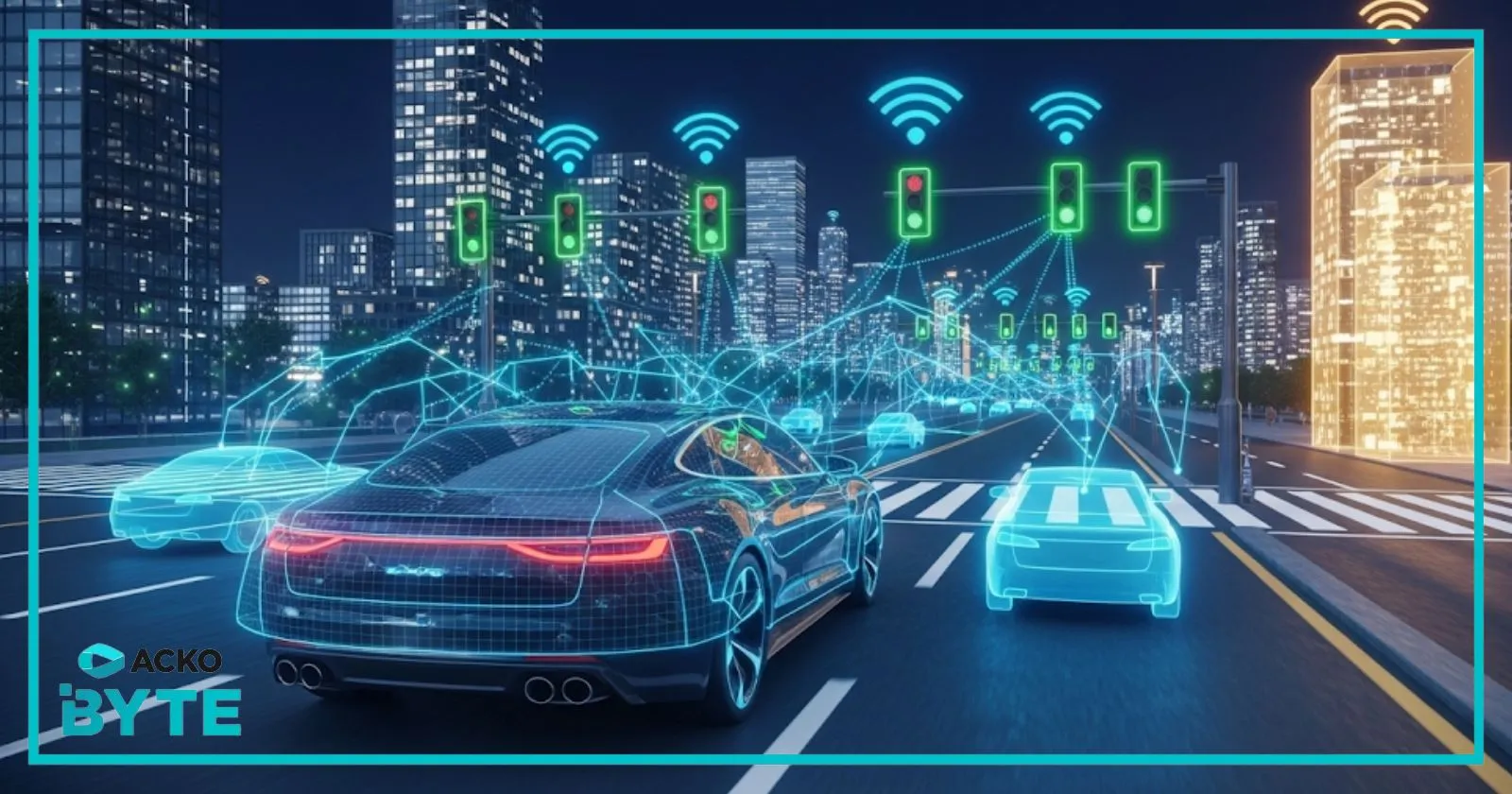
Imagine cars chatting with traffic lights and roads to dodge accidents and ease congestion. V2X technology is redefining driving, and India’s chaotic roads could benefit from it.

Share Post

Imagine cars chatting with traffic lights and roads to dodge accidents and ease congestion. V2X technology is redefining driving, and India’s chaotic roads could benefit from it.
As urban populations swell and roads become increasingly congested, the need for smarter, safer, and more connected transportation systems has never been greater.
One such emerging solution is Vehicle-to-Everything (V2X) technology, which enables vehicles to communicate wirelessly with their surroundings. V2X systems transmit critical information such as a vehicle’s speed, position, and braking status, as well as road conditions or traffic signal timings, allowing drivers or autonomous systems to make informed decisions.
By providing alerts about hazards beyond a driver’s line of sight, such as a vehicle running a red light or a pedestrian crossing around a corner, V2X enhances situational awareness.
In fact, the U.S. National Highway Traffic Safety Administration estimates that V2X features such as intersection warnings and left-turn assistance could prevent hundreds of thousands of crashes annually.
Additionally, it supports traffic management by optimising routing and signal timings, which can lower fuel consumption, road congestion, and emissions. Another potential application is allowing emergency vehicles to pass through a crowded area more quickly, by alerting other cars of their route in advance.
As cities grow and vehicles become more connected, V2X is poised to be a cornerstone of intelligent transportation systems.
V2X is an umbrella term that encompasses communication between a vehicle and other vehicles (Vehicle-to-Vehicle, or V2V), road infrastructure such as traffic lights and signs (Vehicle-to-Infrastructure, or V2I), pedestrians (Vehicle-to-Pedestrian, or V2P), and even cloud networks (Vehicle-to-Network, or V2N).
At its core, V2X relies on common communications technologies, primarily cellular networks (C-V2X) and dedicated short-range communications (DSRC).
C-V2X, which uses 4G or 5G networks, is increasingly favoured for its ability to operate over longer distances and integrate with existing mobile infrastructure.
In fact, the 5G Automotive Association (5GAA), comprising over 130 companies including automakers like Audi, BMW, Ford, and Toyota, as well as telecom giants, actively favour C-V2X over DSRC.
DSRC, on the other hand, uses a specific radio frequency (5.9 GHz in the USA) reserved for vehicle communications, offering direct low-latency connections but requiring dedicated roadside units.
Let’s consider the example of Verizon’s new Edge Transportation Exchange. It recently launched in the USA, and is a mobile-network-based V2X platform.
This platform leverages Verizon’s 4G and 5G networks, mobile edge computing (MEC) infrastructure and precise location technology, which the company says allows for low latency and high reliability. It's meant to be scalable at the city level.
Automakers, technology developers, and governments can build connected mobility solutions using standardised tools and interfaces. Volkswagen is one of Verizon's customers already exploring its capabilities.
Another successful example comes from China, where Ford and Huawei have already expanded C-V2X in 90+ cities. SAIC and BYD have also embedded C-V2X in vehicles with 5GAA’s support.
V2X technology holds immense potential to address India's unique transportation challenges. It could play a pivotal role in mitigating congestion and preventing accidents.
However, implementing V2X in India will require an approach tailored to our infrastructure and regulatory landscape.
Here are some considerations for successful deployment:
Leveraging Cellular Infrastructure: India’s fast-expanding 5G networks, operated by providers such as Reliance Jio and Bharti Airtel, can support C-V2X systems. Using cellular networks would reduce the need for extensive roadside infrastructure, which could be cost-prohibitive.
Partnerships: Partnerships between automakers, technology providers, and government bodies are essential. Government support, through policies and funding, can accelerate deployment.
Smart City Integration: India’s Smart Cities Mission provides a framework for integrating V2X with smart infrastructure such as intelligent traffic management systems. Pilot projects in metro cities will be essential before any kind of nationwide rollout.
Affordability: India’s price-sensitive market requires cost-effective V2X solutions. Local manufacturing of V2X modules, supported by initiatives like Make in India, could further reduce costs.
While V2X technology offers great potential for transforming India’s transportation landscape, its implementation will face several challenges.
Latency: V2X systems depend on low-latency communication to ensure real-time data exchange for critical applications such as collision avoidance and emergency braking alerts. In India, where 5G networks are still in the early stages of deployment, latency issues will definitely arise, particularly in rural and underserved areas with limited coverage.
Traffic Conditions: Our country’s mixed traffic environment, with pedestrians, cyclists, and livestock sharing roads, complicates V2X deployment, as systems must account for non-connected road users.
Cybersecurity: V2X systems transmit sensitive data such as vehicle location and speed, which could raise privacy and security concerns. Malicious actors could feed inaccurate data to networks in order to cause problems. V2X technology could have unintended effects without proper encryption standards. India’s evolving data protection framework, such as the Personal Data Protection Bill, may need to address these risks explicitly.
By 2030, as India’s automotive and telecom sectors grow, V2X could transform its transportation landscape. With government support and telecom partnerships, India can implement V2X to reduce accidents, ease congestion, and support sustainable mobility.
This will require investment, collaboration, and policy regulation, but the potential to reduce accidents and build smarter cities makes it an essential step forward.
2026 ACKO Drive Awards: Ducati Wins the 2026 Premium ADV Motorcycle TOTM With the Multistrada V2
Acko Drive Team 22 Dec, 2025, 8:10 PM IST
ACKO Drive Awards 2026: KTM 390 Adventure X Bags the 2026 ADV Motorcycle TOTM
Acko Drive Team 22 Dec, 2025, 7:52 PM IST
Mahindra Disrupts India's Heavy Truck Market with Over 6-Fold Sales Growth
Acko Drive Team 22 Dec, 2025, 2:45 PM IST
Kinetic Partners With Jio Things to Build Connected Electric Scooters
Acko Drive Team 22 Dec, 2025, 1:10 PM IST
Ratan Tata-Founded Electra EV Bets Big on BESS; Inorganic Moves Also Part of Growth Strategy
Sumantra Bibhuti Barooah 22 Dec, 2025, 12:38 PM IST
Looking for a new car?
We promise the best car deals and earliest delivery!
